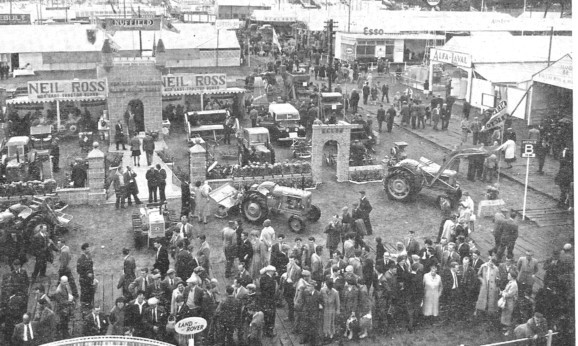For enthusiasts of our agricultural, transport or industrial past, moving images have much to offer,
Finding undiscovered film stock is probably beyond the average vintage enthusiast unless family archives exist.
Plenty of archive film has been taken by specialists and transferred on to modern media such as DVDs but, like me, you may have exhausted that resource.
However, access to a PC and broadband opens up a new world of celluloid entertainment.
While looking for material about the Leyland Plant at Bathgate on the internet I stumbled across a huge volume of old film. A page of search results indicated film of BMC products, and clicking on that opened up the archive for Pathe News Reels.
Now on nights with nothing on ‘the box’, all I have to do is switch on the laptop and type www.britishpathe.com into the search engine.
Pathe was set up in London in 1902, and in 1910 Pathe Newsreels began producing films for the new cinemas springing up. The newsreel would last about five minutes and contain four or five stories.
These early films were silent, but by the mid-1930s sound came along.
During the war and post-war austerity period they were at their zenith, with men like Bob Danvers Walker behind the microphone. By this time the length had increased to 10 minutes, and two a week were distributed.
Pathe had competition from the likes of British Movietone and Gaumont.
As cinema declined in the 1960s due to television so did the newsreels, and Pathe ceased making them in 1970.
Thankfully their huge archive is available to view on the Pathe News site.
Type in ‘agriculture’, and hundreds of film clips come up. Some last as little as 60 seconds, and others for more than 20 minutes. Some are silent, others have sound.
The vast majority are black and white, but there are a few gems in colour.
Many films are of particular relevance to Scotland, including travelogues giving a flavour of local life, and often there are lovely rural shots. One such film is Busman’s Holiday from 1960.
Short films attracting people to help with the Scottish harvest in the 1940s feature strongly, as do films of the Highland Show at pre- and post-war locations including the early years at Ingliston.
These films concentrate mainly on livestock, but there are some shots of tractors and machinery.
It is the same story with English shows such as Bath and West, the Royal Windsor, the Royal and Smithfield where MF, Ford, DB and Nuffield all feature.
Some other Scottish films of note include cattle being loaded at Oban and a sale at Dingwall, while colour film from 1959 shows the Montrose Raspberry Festival.
Further colour film comes from the West of Scotland College at Auchencruive, where work on potato cyst eelworm is shown, complete with Nuffield tractors.
This film is one of several commissioned by BMC to promote not only their tractors but cars, lorries and vans.
Helping Hands is a colour film lasting 18 minutes and contains footage of Nuffield P4 and Universal tractors undertaking numerous farming tasks in the mid-1950s.
These include dung loading with a poppy red Horndraulic loader, ploughing with a single-furrow Ransome reversible, and a three-furrow conventional that looks like the Fisher Humphries approved plough that interestingly has the Nuffield Decal on the handles.
Other Nuffield approved implements include a Taskers trailer, Leverton Steerage Hoe and a Scotmec Hammermill which has the Nuffield badge on the cyclone.
Further jobs undertaken were sweeping hay with a push-off hay sweep on the Horndraulic, and threshing and baling with an unknown mill and Jones baler.
Another lovely Nuffield film shows potato growing in 1962 with Nuffield tractors carrying out all the operations.
Perhaps some of the most fascinating film goes right back to the early years, with silent black and white images of a Burford Clayton Crawler ploughing with a rotary-type plough similar to that made by Massey Harris.
Other First World War films are Ploughing Up The Parks from 1917 showing an Overtime at work; and Speeding Up Food, showing two Holt crawlers ploughing one with two trailed ploughs, the other with three attached. Internationals and Overtimes are also featured.
Other films show Moline, Fordson F and Cleveland tractors.
The 1919 tractor trials are covered, with footage of Saunderson, Fordson F, Glasgow and pedestrian tractors all at work. This film is entitled 44 Motor Tractors.
The 1930 trials at Wantage are also featured, while Ancient And Modern featuring Fordson F and IH 10/20.
More films from the 1920s include 38th Annual Ploughing Match from Farningham in Kent, with rare film of a Faegol tractor ploughing.
Ten years later we have what looks like an International 15/30 pulling an IH combine in a piece called The Harvesters.
The Second World War provides much in the catalogue, with film of Land Girls very prominent.
Land Girls Get In the Harvest has shots of bindering on “downland” with Fordsons and Sunshine binders. It also shows the girls getting a well-earned tea break from the WRVS van.
New Tractor Demonstrated from 1940 shows the merits of the Ford Ferguson.
Further Fordson demonstrations are featured in the 1949 offering Ford Tractor Demonstration, where Ford put a fleet of E27Ns through their paces in a variety of jobs.
A year earlier, Tank Plough has footage of the Sherman tank operated by Crawford’s in Lincolnshire.
Also from 1948 is Groundnut Scheme, featuring Massey Harris tractors and Clipper combines and Caterpillar and International dozers clearing brush.
This East African interlude was the only piece of film from abroad investigated, but there is much more on offer.
